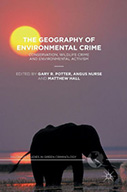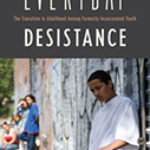The Geography Of Environmental Crime: Conservation, Wildlife Crime, And Environmental Activism

Editors: Gary R. Potter, Angus Nurse, and Matthew Hall
Publisher: London: Palgrave Macmillan, 2016. 228p.
Reviewer: Meredith Gore | October 2018
Environmental crime is a global, complex and high-profile problem. The “environmental crime crisis” is known to undermine the rule of law, remove taxable revenues from legal economies, fuel corruption, endanger species and ecosystems and threaten human health and well-being. In response to environmental crimes such as wildlife trafficking and illegal trade in e-waste, diverse sectors are doubling their efforts to help resolve the problem. New collaborations are rife with innovation and existing partnerships are revising their protocols accordingly. Environmental crime is not a new problem, per se, but the current scope and scale of the problem is historic in its negative impact. Science has an important role in supporting decision-making and decision-makers. Scientists are bringing evidence to action by building new theory, methods and analysis; they are also revising existing approaches.
This volume offers a fresh update to green criminology approaches for thinking about the nature of environmental crime. The editors are widely-known and respected experts in the field of green criminology with established records in both critical and applied scholarship. The main theses Drs. Potter, Nurse, and Hall present in “The Geography of Environmental Crime,” is first, that traditional criminological expertise has much to add to the conversation. Second, considering the criminological dimensions of natural resource exploitation can expose new solution sets, best practices and theoretical critiques. The writing is widely accessible and well-referenced. Chapters use mostly high-level case studies about wildlife-related crime to motivate thinking about harms to the environment, perhaps to maximize alignment of the volume with the Chicago school of research. Africa features prominently in chapter case studies, understandably because of its source, transit, and demand geography for wildlife and wildlife parts. Although other regions of the world are less attended to by the case studies, insights from the volume could be readily transferable to other geographies by the motivated reader. Multidirectional harms and harms embedded in coupled human and natural systems are not a central focus of the volume or its case studies. This book does not offer an exhaustive review of green criminology (or environmental criminology or conservation criminology) perspectives on environmental crime. For example, guardianship and deterrence do not feature prominently. The volume does offer a strong take on the pulse of where green criminology stands in its contribution to the environmental crime crisis; in this regard, a reader can easily gauge the growing maturity of the subdiscipline.
In Part 1, chapters on tiger poaching and radical environmentalism offer a sampling of disciplinary lenses that can be worn to diagnose and decipher the problems associated with environmental crime. These chapters offer prescriptions for directing law enforcement interventions based on social scientific evidence. Chapter 4 probes one of the main tropes of contemporary environmental crime, and that is its purported connections to terrorism and ideologue-driven violence. Concomitantly, this chapter serves as both an echo chamber for the trope and stage for important questions about surveillance, civil rights, and resource allocation. The chapter briefly considers the divergence of environmental from other serious crimes when considering the millions of dollars spent on combatting (eco) terrorism. This is a highly unique perspective and one that likely merits further attention.
In Part 2, solutions for law enforcement and crime prevention are detailed via attention to methods and models such as biological traceability and conservation governance. The remarkable breadth of traceability techniques, including DNA barcoding and chemical marking, are profiled from the perspective of law enforcement authorities and evidence collection experts. The downstream implications of these law enforcement solutions, such as evidentiary standards or use in successful prosecutions, are less developed. Chapter 6 offers a meaningful green criminology contribution to the growing literature on “militarized conservation,” generating many questions over answers. For example, the construction of poachers in Africa as being criminal offenders living within rural communities and driven by fundamental livelihood needs is labeled as oversimplified, but the implications of the hierarchical constructions are not explained. North/South issues are identified, yet the implications from public exclusion for private benefit are unclear. The topic of militarized conservation has mostly been the purview of political ecologists and it is very intriguing to consider the green criminological perspective.
Part 3 concludes the volume with a critical review of law enforcement in the environmental crime space. Although restricted to Scandinavian examples from the global North, chapters dissect many assumptions and rationalizations associated with conservation law enforcement in general and the preferred solutions of criminal justice professionals. The false equivalency of environmental crime and environmental harm is explained. Chapter 9, in discussing neutralization of hunting, begins to tease out nuances in the relationship between criminology and crime science within the environmental space. The difference between creating laws and enforcing laws is explored within the context of Scandinavia. Readers are not cautioned about the shortcomings of the critical green criminology perspective on considering North/South issues that factor prominently in conservation social science. Impressively, the strengths of green criminology’s theoretical contributions to understanding and resolving environmental crime shine through in this section.
A reader could approach the volume in a piecemeal fashion, as each chapter is able to stand alone as an illustration of discrete principles relevant to environmental, mainly wildlife, crime. When the book is read as a comprehensive compilation, the reader is left with enhanced capacity to think about many aspects of the bigger picture, as chapters cross-sensitize principles and methods. This is no easy task. Critical desk reviews complement field-based inquiry conducted under both quantitative and qualitative paradigms. The depth of the volume, when taken as a whole, could have been enhanced by co-authorship with conservation social scientists and attention to the North/South debate central to the problem of contemporary environmental crimes. Other strengths from green criminology, such as comparative gender and justice issues or criminology’s restorative justice, are missing. Including the green criminologists’ perspectives on environmental crime using these approaches would only add to the thought-provoking volume.
The main thesis of the editors, which is convincingly supported, is that traditional criminological expertise has much to add to the discourse about the problems of and solutions for the global environmental crime crisis. In this regard, The Geography of Environmental Crime is emblematic of the myriad strengths of green criminology.
Meredith L. Gore, Associate Professor, Michigan State University


